California has more electric cars than any other state, but now the high cooling demands due to a heat wave could impact drivers' ability to charge their EVs.
The state's Independent System Operator (ISO), which oversees the electricity grid, twice asked Californians to conserve energy during specific periods—dubbed Flex Alerts—on a voluntary basis, Newsweek reported. EV charging was included in a list of conservation tips the ISO posted on Twitter, along with things like avoiding use of large appliances, and turning off extra lights.
A report from a San Francisco CBS affiliate noted that drivers were seen charging at a public station during one of the recent Flex Alerts, with one driver saying they had no choice, and needed the charge to get home.
It's not an ideal situation for the state that has done more than any to promote electric cars, and hopes to end sales of new gasoline cars by 2035.

Nissan Leaf charging at EVgo fast charger in Baker, California
Concern about EV charging during periods of high stress on the grid isn't new, though. Utilities previously said the state will need massive grid upgrades to deal with the higher demand of EVs from that 2035 goal.
The state needs about 1.2 million charging stations by 2030 to support the 2035 goal, up from the current 73,000 stations, according to a recent California Energy Commission report.
Bidirectional charging could help stabilize the grid in the future, but in the meantime smart charging that's mindful of peak and off-peak times will help tremendously, utilities claim.
California definitely needs to avoid the optics of last year, when it relied on diesel generators to supplement power production and "gaps" in reliability as the grid struggled to keep up with high demand, and parts of the state experienced rolling blackouts.












